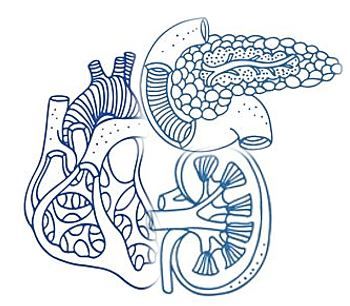Irregular Menstrual Cycle Associated with Cardiometabolic Conditions in Women Regardless of PCOS Status
New research shows that menstrual irregularity is associated with a higher prevalence of cardiometabolic conditions in women, even in the absence of PCOS.

New data from the Apple Women’s Health Study show that polycystic ovary syndrome (PCOS) is associated with a higher prevalence of cardiometabolic conditions, such as type 2 diabetes (T2D) and hypertension (HTN).
Also, findings from the analysis of over 60 000 women who self-reported menstrual cycle and other hormone-related data via the Apple research app showed that longer time to menstrual cycle regularity since menarche or irregular cycles in adulthood were associated with a higher prevalence of certain cardiometabolic conditions, even among those without PCOS. Some of these associations were modified by body mass index (BMI) or physical activity levels, researchers noted in JAMA Network Open.
“These findings suggest that early screening of cardiometabolic risk factors and interventions may benefit individuals with longer times to regular menstrual cycles or who experience adulthood irregular cycles, regardless of PCOS diagnosis,” corresponding author Zifan Wang, PhD, MS, of Harvard TH Chan School of Public Health in Boston, Massachusetts, and colleagues wrote.
PCOS is a common ovulatory condition impacting reproductive-aged women that is characterized by irregular cycles and hyperandrogenism, although not all women with irregular menstrual cycles are diagnosed with PCOS, either because the diagnosis is missed or the irregularity has another cause such as hypothalamic amenorrhea.
Previous research has shown positive associations between PCOS and cardiometabolic conditions, and between irregular cycles and cardiovascular disease or premature death. However, there is limited data on whether these associations differ based on PCOS status or potential interventions, according to the study.
“In addition, most of these studies were limited to menstrual patterns during adulthood,” investigators added. “Early-life characteristics, such as time to regularity since menarche, are important but understudied variables in cardiometabolic health.”
To address these gaps in existing research, Wang and colleagues conducted the cross-sectional study examining the associations of PCOS, time to regularity since menarche (adolescence), and irregular cycles (adulthood) with cardiometabolic conditions. They analyzed data from 60 789 women (mean age, 34.5 years; 71.4% White) who were enrolled in the Apple Women’s Health Study from November 2019 to December 2022 and met the following eligibility criteria: had ever menstruated, lived in the US, were aged at least 18 years, and were able to communicate in English.
Participants were asked to complete 5 surveys assessing medical and reproductive history, hormonal symptoms, and general health and lifestyle upon enrollment. Researchers restricted analyses to women who completed the demographics survey and at least 1 of the 4 remaining surveys, according to the study.
PCOS status was based on self-reported physician diagnosis at enrollment. Wang and coauthors assessed prolonged time to menstrual regularity using the question, “After your first menstrual cycle, how long did it take for your cycle to become regular?” and defined “prolonged” as more than 5 years, after using hormones or not yet regular.
The primary outcome was self-reported cardiometabolic conditions, including obesity, prediabetes, type 1 diabetes, T2D, hypercholesterolemia, HTN, metabolic syndrome, arrhythmia, congestive heart failure (CHF), coronary artery disease (CAD), myocardial infarction, heart valve disease, stroke, transient ischemic attack (TIA), deep vein thrombosis (DVT), and pulmonary embolism.
Findings
Within the cohort, 12.3% of participants had PCOS and 26.3% reported prolonged time to menstrual regularity. Among a subset of 25 399 participants who completed the hormonal symptoms survey, 25.6% reported irregular cycles, investigators found.
After researchers adjusted for all covariates (eg, age, race/ethnicity, socioeconomic status) they observed that PCOS was associated with a higher prevalence of all metabolic conditions, including obesity (prevalence odds ratio [POR] 2.94, 95% CI 2.77-3.12), prediabetes (POR 3.75, 95% CI 3.47-4.06), type 1 diabetes (POR 1.43, 95% CI 1.07-1.90), T2D (POR 2.76, 95% CI 2.43-3.15), hypercholesterolemia (POR 1.68, 95% CI 1.55-1.81), HTN (POR 1.57, 95% CI 1.45-1.70), and metabolic syndrome (POR 3.28, 95% CI 2.94-3.66), as well as cardiovascular conditions, including arrhythmia (POR 1.37, 95% CI 1.20-1.55), CAD (POR 2.92, 95% CI 1.95-4.29), heart attack (POR 1.79, 95% CI 1.23-2.54), stroke (POR 1.66, 95% CI 1.21-2.24), TIA (POR 1.87, 95% CI 1.44-2.40), DVT (POR 1.54, 95% CI 1.24-1.89), and pulmonary embolism (POR 1.83, 95% CI 1.43-2.32).
Among the 37 707 participants without PCOS, prolonged time to menstrual regularity was associated with a higher prevalence of prediabetes (POR 1.20, 95% CI 1.08-1.33), type 1 diabetes (POR 1.52, 95% CI 1.16-1.99), T2D (POR 1.24, 95% CI 1.05-1.46), HTN (POR 1.09, 95% CI 1.01-1.19), arrythmia (POR 1.20, 95% CI 1.06-1.35), and TIA (POR 1.33, 95% CI 1.01-1.73). Similarly, women without PCOS who reported having irregular cycles were more likely to have T2D (POR 1.36, 95% CI 1.08-1.69), hypercholesterolemia (POR 1.17, 95% CI 1.05-1.30), arrhythmia (POR 1.21, 95% CI 1.02-1.43), and TIA (POR 1.56, 95% CI 1.06-2.26).
“We also found effect modification by BMI and physical activity for the associations between PCOS or irregular cycles and certain cardiometabolic conditions, which has rarely been reported in population-based studies,” Wang et al noted. “While future studies with longitudinal data are warranted, our findings suggest the benefit of early intervention, such as weight management and exercise, that may help to alleviate cardiometabolic conditions among individuals with PCOS and/or irregular cycles.”
Reference: Wang Z, Jukic AMZ, Baird DD, et al. Irregular cycles, ovulatory disorders, and cardiometabolic conditions in a US-based digital cohort. JAMA Netw Open. Published online May 3, 2024. doi:10.1001/jamanetworkopen.2024.9657